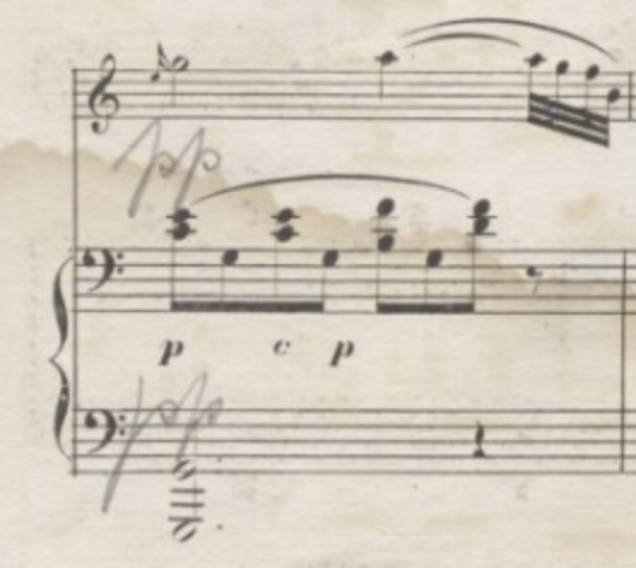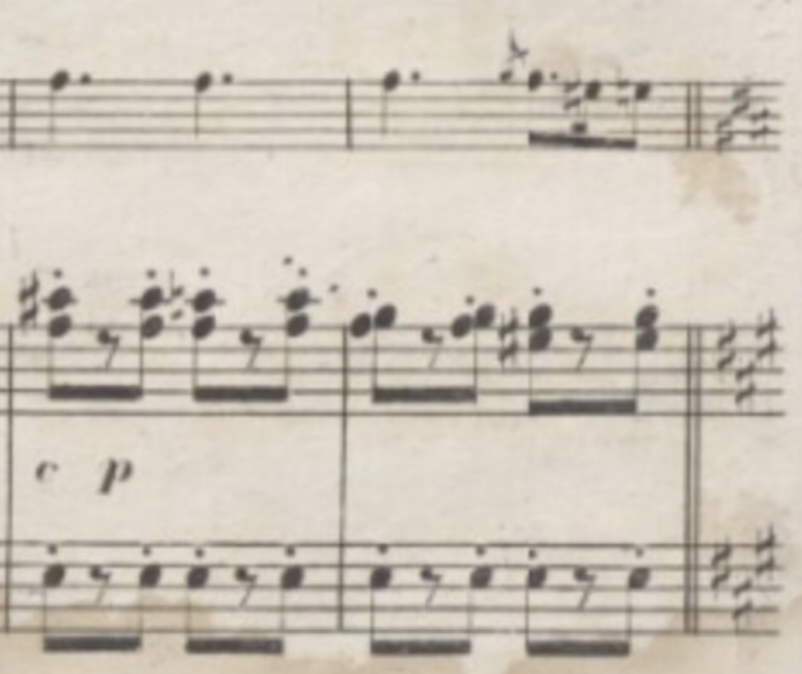Page 1 of 2
What is this "c. P" symbol?
Posted: 05 Oct 2022, 07:12
by NeeraWM
Hello,
I have found this in the work I'm currently engraving, for cello and piano.

- Screenshot 2022-10-04 at 10.04.55.png (2.81 MiB) Viewed 4843 times
Do you know what this is?
Have you ever encountered it?
It happens a few times during the piece.
I suspect it is a non-standard way of saying "con Pedale", but am not sure.
Thank you
Re: What is this "c. P" symbol?
Posted: 05 Oct 2022, 10:30
by Callasmaniac
Might be "colla parte" - follow the soloist.
Re: What is this "c. P" symbol?
Posted: 05 Oct 2022, 12:14
by John Ruggero
Curious. Colla parte seems right given the subito pp and the rests at the end of the measure as if to give time to the soloist to play freely. Pedaling seems less likely. Seeing the whole piece might be helpful. One would think that the pp should come on the first beat as in the solo part.
Re: What is this "c. P" symbol?
Posted: 05 Oct 2022, 13:47
by NeeraWM
Indeed there are pencil markings later in the piece where this excerpt repeats stating PP on the first beat.
The rest of the piece doesn't have any of these markings.
Style is from second half of XIX century.

- Screenshot 2022-10-05 at 15.45.21.png (436.14 KiB) Viewed 4827 times
What makes me think this is not a "colla parte" is the typeface used for the P, like it is a Piano again.
What about "corda" as in "use the 1c pedal?
Did the piano have the 1c pedal in the second half of XIXc?
Ah, also ... many other passages have virtuoso bar endings, and none of them apart from this one has c.p.
Re: What is this "c. P" symbol?
Posted: 05 Oct 2022, 23:15
by John Ruggero
Beethoven writes "una corda", "due corda" and "tre corda" and abbreviates u.c. d.c. and t.c. during the 1820s. Never saw c. p as a pedal mark, however. One does see pf where the "poco" is written in the same font as p. And soft pedal indications seem unlikely in what looks like a rudimentary accompaniment. But who knows.
Judging from the two examples, the piece seems to be very "loosely" edited. I would imagine that the manuscript is similar i.e. a mess. The notation may be home-grown or the result of a misunderstanding of the manuscript. subito p or pp also comes to mind for this spot but I don't see how that relates to c. p
Re: What is this "c. P" symbol?
Posted: 06 Oct 2022, 03:37
by Fred G. Unn
Musically I've only seen this with metronome markings, and have no idea of the historical accuracy in this case, but is it possible c is an abbreviation for circa? Approximately piano?
Re: What is this "c. P" symbol?
Posted: 06 Oct 2022, 19:16
by John Ruggero
circa p seems unlikely since the solo part is pp. And like you, I've only seen "circa" used with metronome markings starting in the 20th century. I think this piece is going to need a lot of editorial intervention.
Re: What is this "c. P" symbol?
Posted: 07 Oct 2022, 10:24
by NeeraWM
Yes, that's what I'm doing.
In any case, I'm removing that "c.P" as it doesn't add anything apparently meaningful to the score.
I'm uniforming the dynamic of that passage to the same PP it should be and is shown in another parts.
Then, Critical Notes will do the rest.
Re: What is this "c. P" symbol?
Posted: 07 Oct 2022, 21:20
by Tpaloj
This is an interesting case. I don't think "c. P." is being meant as "colla parte" as the P should be written in normal font and not italic were that the case. It's too brief a pasage for a cresc. abbrevation yet it's curious how the "c" is very specifically engraved strictly under the e-c chord in your latter screenshot. I don't believe any "circa p" is meant by this: "circa" is reserved for tempo instructions for sure. "Con piano" is a remote possibility but it's too obscure to be sure.
Re: What is this "c. P" symbol?
Posted: 07 Oct 2022, 22:37
by NeeraWM
A cellist colleague votes for "colla parte".
The symbol appears again in the second piece of the collection, where the piece transitions to A major and it is possible that the accompaniment needs to follow.

- Screenshot 2022-10-08 at 00.34.06.png (600.26 KiB) Viewed 4735 times
The composer (Cossmann) is not famous overall, and is well known only by cellists for one technical exercise he wrote that is, basically, the most useful technical exercise every written :-D
Here is a picture of the publisher signature, do you know this house?

- Screenshot 2022-10-08 at 00.35.58.png (353.64 KiB) Viewed 4735 times